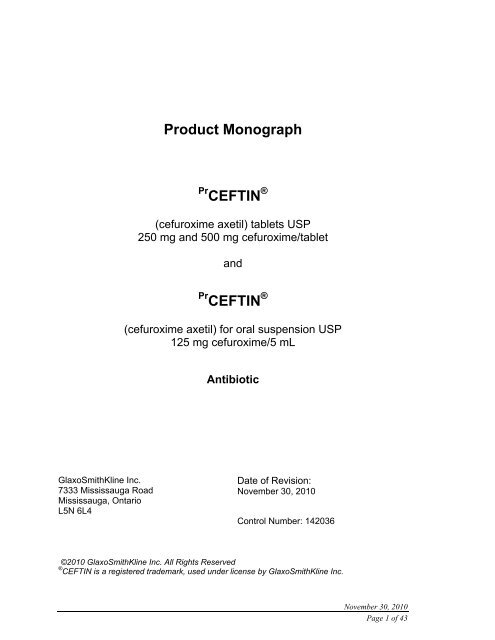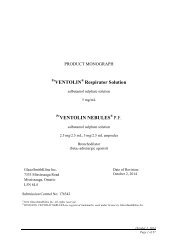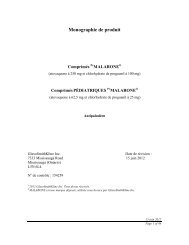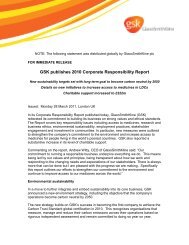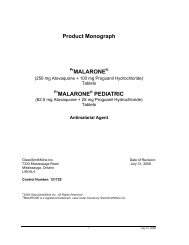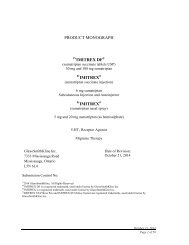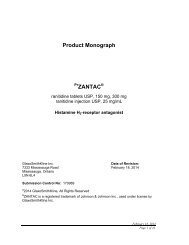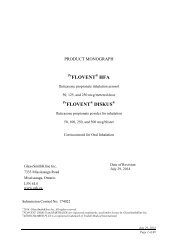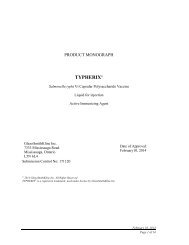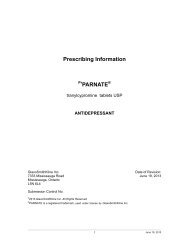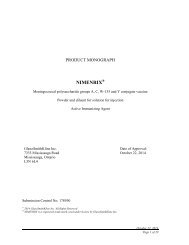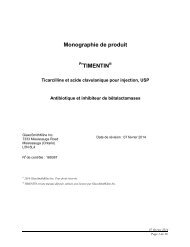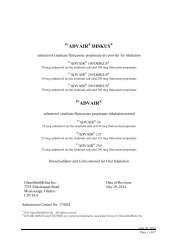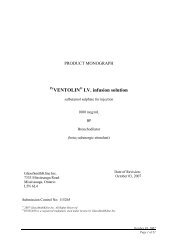Product Monograph PrCEFTIN® PrCEFTIN® - GlaxoSmithKline
Product Monograph PrCEFTIN® PrCEFTIN® - GlaxoSmithKline
Product Monograph PrCEFTIN® PrCEFTIN® - GlaxoSmithKline
Create successful ePaper yourself
Turn your PDF publications into a flip-book with our unique Google optimized e-Paper software.
<strong>GlaxoSmithKline</strong> Inc.<br />
7333 Mississauga Road<br />
Mississauga, Ontario<br />
L5N 6L4<br />
<strong>Product</strong> <strong>Monograph</strong><br />
Pr CEFTIN ®<br />
(cefuroxime axetil) tablets USP<br />
250 mg and 500 mg cefuroxime/tablet<br />
and<br />
Pr CEFTIN ®<br />
(cefuroxime axetil) for oral suspension USP<br />
125 mg cefuroxime/5 mL<br />
Antibiotic<br />
Date of Revision:<br />
November 30, 2010<br />
Control Number: 142036<br />
©2010 <strong>GlaxoSmithKline</strong> Inc. All Rights Reserved<br />
® CEFTIN is a registered trademark, used under license by <strong>GlaxoSmithKline</strong> Inc.<br />
November 30, 2010<br />
Page 1 of 43
<strong>Product</strong> <strong>Monograph</strong><br />
Pr CEFTIN ®<br />
(cefuroxime axetil) tablets USP<br />
250 mg and 500 mg cefuroxime/tablet<br />
Pr CEFTIN ®<br />
(cefuroxime axetil) for oral suspension USP<br />
125 mg cefuroxime/5 mL<br />
Antibiotic<br />
Actions and Clinical Pharmacology<br />
Cefuroxime axetil is an orally active prodrug of cefuroxime. After oral administration,<br />
cefuroxime axetil, as CEFTIN ® , is absorbed from the gastrointestinal tract and rapidly<br />
hydrolyzed by nonspecific esterases in the intestinal mucosa and blood to release<br />
cefuroxime into the blood stream. Conversion to cefuroxime, the microbiologically active<br />
form, occurs rapidly. The inherent properties of cefuroxime are unaltered after its<br />
administration as cefuroxime axetil. Cefuroxime exerts its bactericidal effect by binding<br />
to an enzyme or enzymes referred to as penicillin-binding proteins (PBPs) involved in<br />
bacterial cell wall synthesis.<br />
___________________<br />
* All references to CEFTIN ® in this monograph include CEFTIN ® for Oral Suspension unless<br />
otherwise specified.<br />
** All dosages are expressed in terms of cefuroxime (base).<br />
November 30, 2010<br />
Page 2 of 43
This binding results in inhibition of bacterial cell wall synthesis and subsequent cell<br />
death. Specifically, cefuroxime shows high affinity for PBP 3, a primary target for<br />
cefuroxime in gram-negative organisms such as E. coli.<br />
Indications and Clinical Uses<br />
CEFTIN ® (cefuroxime axetil) is indicated for the treatment of patients with mild to<br />
moderately severe infections caused by susceptible strains of the designated organisms<br />
in the following diseases:<br />
Upper Respiratory Tract Infections<br />
Pharyngitis and tonsillitis caused by Streptococcus pyogenes.<br />
Otitis Media caused by Streptococcus pneumoniae, Streptococcus pyogenes (group A<br />
beta-hemolytic streptococci), Haemophilus influenzae (beta-lactamase negative and<br />
beta-lactamase positive strains) or Moraxella catarrhalis. Sinusitis caused by Moraxella<br />
catarrhalis, Streptococcus pneumoniae or Haemophilus influenzae (including ampicillin-<br />
resistant strains).<br />
Lower Respiratory Tract Infections<br />
Pneumonia or bronchitis caused by Streptococcus pneumoniae, Haemophilus influenzae<br />
(including ampicillin-resistant strains), Haemophilus parainfluenzae, Klebsiella<br />
pneumoniae or Moraxella catarrhalis.<br />
November 30, 2010<br />
Page 3 of 43
Skin Structure Infections<br />
Skin structure infections caused by Staphylococcus aureus, Streptococcus pyogenes or<br />
Streptococcus agalactiae.<br />
Gonorrhea<br />
Acute uncomplicated urethritis and cervicitis caused by Neisseria gonorrheae.<br />
Bacteriologic studies to determine the causative organism and its susceptibility to<br />
cefuroxime should be performed. Once these results become available antibiotic<br />
treatment should be adjusted if required.<br />
Contraindications<br />
CEFTIN ® (cefuroxime axetil) is contraindicated for patients who have shown Type 1<br />
hypersensitivity to cefuroxime, to any of its components, or to any of the cephalosporin<br />
group of antibiotics.<br />
Warnings<br />
Before therapy with CEFTIN® (cefuroxime axetil) is instituted, careful inquiry should be<br />
made to determine whether the patient has had previous hypersensitivity reactions to<br />
cefuroxime, cephalosporins, penicillin, or other drugs. CEFTIN® should be administered<br />
with caution to any patient who has demonstrated some form of allergy, particularly to<br />
drugs. There is some clinical and laboratory evidence of partial cross-allergenicity of the<br />
cephalosporins and penicillin. Special care is indicated in patients who have<br />
November 30, 2010<br />
Page 4 of 43
experienced anaphylactic reaction to penicillins or other beta-lactams. If an allergic<br />
reaction to CEFTIN® occurs, treatment should be discontinued and standard agents<br />
(e.g. epinephrine, antihistamines, corticosteroids) administered as necessary.<br />
CEFTIN ® suspension contains aspartame, which is a source of phenylalanine and so<br />
should be avoided in patients with phenylketonuria.<br />
Clostridium difficile-Associated Disease<br />
Pseudomembranous colitis has been reported to be associated with the use of CEFTIN ®<br />
and other broad-spectrum antibiotics. Therefore, it is important to consider its diagnosis<br />
in patients administered CEFTIN ® who develop diarrhea. Treatment with broad<br />
spectrum antibiotics, including CEFTIN ® , alters the normal flora of the colon and may<br />
permit overgrowth of Clostridia. Studies indicate that a toxin produced by Clostridium<br />
difficile is one primary cause of antibiotic associated colitis. Mild cases of colitis may<br />
respond to drug discontinuance alone. Moderate to severe cases should be managed<br />
with fluid, electrolyte, and protein supplementation as indicated. When the colitis is<br />
severe or not relieved by discontinuance of CEFTIN ® administration, consideration<br />
should be given to the administration of oral vancomycin or other suitable therapy.<br />
Other possible causes of colitis should also be considered.<br />
Hemolytic Anemia<br />
CEFTIN SHOULD NOT BE USED IN PATIENTS WITH A HISTORY OF<br />
CEPHALOSPORIN-ASSOCIATED HEMOLYTIC ANEMIA SINCE THE RECURRENCE<br />
OF HEMOLYSIS IS MUCH MORE SEVERE.<br />
An immune mediated hemolytic anemia has been observed in patients receiving<br />
cephalosphorin class antibacterials, including CEFTIN. Severe cases of hemolytic<br />
November 30, 2010<br />
Page 5 of 43
anemia, including fatalities, have been reported in both adults and children. If a patient<br />
develops anemia anytime during, or within 2-3 weeks subsequent to the administration<br />
of CEFTIN, the diagnosis of a cephalosphorin-associated amenia should be considered<br />
and the drug discontinued until the etiology is determined.<br />
Patients may benefit from periodic monitoring for signs and symptoms of hemolytic<br />
anemia, including measurement of hematological parameters or drug-induced antibody<br />
testing, where appropriate (see PRECAUTIONS and ADVERSE REACTIONS).<br />
General<br />
Precautions<br />
Broad-spectrum antibiotics including CEFTIN ® (cefuroxime axetil) should<br />
be administered with caution to individuals with a history of gastrointestinal disease,<br />
particularly colitis.<br />
The concomitant administration of aminoglycosides and some cephalosporins has<br />
caused nephrotoxicity. There is no evidence that CEFTIN ® , when administered alone, is<br />
nephrotoxic, although transient elevations of BUN and serum creatinine have been<br />
observed in clinical studies. However, the effect of administering CEFTIN ®<br />
concomitantly with aminoglycosides is not known.<br />
Studies suggest that the concomitant use of potent diuretics, such as furosemide and<br />
ethacrynic acid, may increase the risk of renal toxicity with cephalosporins.<br />
As with other antibiotics, use of CEFTIN ® may result in the overgrowth of Candida.<br />
Prolonged use may also result in the overgrowth of other non-susceptible organisms<br />
(e.g. enterococci and Clostridium difficile), which may require interruption of treatment.<br />
November 30, 2010<br />
Page 6 of 43
Repeated evaluation of the patient's condition is essential. If superinfection occurs<br />
during therapy, appropriate measures should be taken. Should an organism become<br />
resistant during antibiotic therapy, CEFTIN ® should be discontinued and another<br />
appropriate antibiotic should be substituted.<br />
The sucrose content of CEFTIN ® suspension (see PHARMACEUTICAL<br />
INFORMATION) should be taken into account when treating diabetic patients.<br />
Pregnancy<br />
The safety of CEFTIN ® in pregnancy has not been established. The use of CEFTIN ® in<br />
pregnant women requires that the likely benefit from the drug be weighed against the<br />
possible risk to the mother and fetus. Animal studies following parenteral administration<br />
have shown cefuroxime to affect bone calcification in the fetus and to cause maternal<br />
toxicity in the rabbit. Reproduction studies that have been performed in mice and rats at<br />
oral doses of up to 50 to 160 times the human dose have revealed no evidence of<br />
impaired fertility or harm to the fetus due to cefuroxime axetil. There are, however, no<br />
adequate and well-controlled studies in pregnant women. Because animal reproduction<br />
studies are not always predictive of human response, this drug should be used during<br />
pregnancy only if clearly needed.<br />
Nursing Mothers<br />
Since cefuroxime is excreted in human milk, consideration should be given to<br />
discontinuing nursing temporarily during treatment with CEFTIN ® .<br />
November 30, 2010<br />
Page 7 of 43
Drug Interactions<br />
Drugs which reduce gastric acidity may result in a lower bioavailability of CEFTIN ®<br />
compared with that of the fasting state and tend to cancel the effect of enhanced post-<br />
prandial absorption.<br />
In common with other antibiotics, cefuroxime axetil may affect the gut flora, leading to<br />
lower estrogen reabsorption and reduced efficacy of combined oral contraceptives.<br />
Drug-Laboratory Test Interactions<br />
A false-positive reaction for glucose in the urine may occur with copper reduction tests<br />
(Benedict's or Fehling's solution or with Clinitest ® Tablets) but not with enzyme-based<br />
tests for glycosuria (e.g. Clinistix ® , Tes-Tape ® ). As a false-negative result may occur in<br />
the ferricyanide test, it is recommended that either the glucose oxidase or hexokinase<br />
method be used to determine blood plasma glucose levels in patients receiving<br />
CEFTIN ® .<br />
Cefuroxime does not interfere with the assay of serum and urine creatinine by the<br />
alkaline picrate method.<br />
Cephalosporins as a class tend to be absorbed onto the surface of red cell membranes<br />
and react with antibodies directed against the drug to produce a positive Coombs’ test<br />
(which can interfere with cross-matching of blood) and very rarely hemolytic anemia<br />
(See WARNINGS and ADVERSE REACTIONS).<br />
Ability to Perform Tasks That Require Judgement, Motor or Cognitive Skills<br />
As this medicine may cause dizziness, patients should be warned to be cautious when<br />
driving or operating machinery.<br />
November 30, 2010<br />
Page 8 of 43
Adverse Reactions<br />
The following adverse reactions have been reported:<br />
Gastrointestinal (approximately 8% of patients): Diarrhea (5.6%), nausea (2.4%),<br />
vomiting (2.0%), loose stools (1.3%). Reports of abdominal pain have occurred.<br />
Hepatic (3% of patients): Transient increases of hepatic enzyme levels [ALT (SGPT),<br />
AST (SGOT), LDH].<br />
Central Nervous System (2.2% of patients): Headache and dizziness.<br />
Hypersensitivity (1.3% of patients): Rashes (0.6%), pruritus (0.3%), urticaria (0.2%),<br />
shortness of breath and rare reports of bronchospasm. Hypersensitivity reactions to<br />
CEFTIN ® may occur in patients who report delayed hypersensitivity to penicillins (see<br />
WARNINGS). As with other cephalosporins, there have been rare reports of drug fever.<br />
Hematologic: increased erythrocyte sedimentation rate, eosinophilia, decreased<br />
hemoglobin and very rarely hemolytic anemia (see WARNINGS and PRECAUTIONS).<br />
Miscellaneous: The following adverse reactions have been observed to occur,<br />
although infrequently, in association with parenteral cefuroxime sodium and may be<br />
potential adverse effects of oral cefuroxime axetil: drowsiness, vaginitis, positive direct<br />
Coombs test, and transient increases in serum bilirubin, creatinine, alkaline<br />
phosphatase, and urea nitrogen (BUN). In addition, the incidence of diaper rash (1.4%)<br />
has been associated with CEFTIN ® suspension in children.<br />
November 30, 2010<br />
Page 9 of 43
POSTMARKETING EXPERIENCE WITH CEFTIN ® PRODUCTS<br />
In addition to adverse events reported during clinical trials, the following events have<br />
been identified during clinical practice in patients treated with CEFTIN ® Tablets or with<br />
CEFTIN ® for Oral Suspension and were reported spontaneously. Data are generally<br />
insufficient to allow an estimate of incidence or to establish causation.<br />
General: The following hypersensitivity reactions have been reported: anaphylaxis,<br />
angioedema, pruritus, rash, serum sickness-like reaction, urticaria.<br />
Gastrointestinal: Pseudomembranous colitis (see WARNINGS).<br />
Hematologic: thrombocytopenia, and leucopenia (sometimes profound).<br />
Hepatic: Jaundice (predominantly cholestatic) and hepatitis have been reported very<br />
rarely.<br />
Infections and Infestations Candida overgrowth.<br />
Neurologic: Seizure.<br />
Skin: Erythema multiforme, Stevens-Johnson syndrome, toxic epidermal necrolysis.<br />
Urologic: Renal dysfunction.<br />
Symptoms and Treatment of Overdosage<br />
For management of a suspected drug overdose, contact your regional Poison Control<br />
Centre.<br />
November 30, 2010<br />
Page 10 of 43
Other than general supportive treatment, no specific antidote is known. Excessive<br />
serum levels of cefuroxime can be reduced by dialysis. For treatment of hypersensitive<br />
reactions, See WARNINGS.<br />
Dosage and Administration<br />
CEFTIN ® (cefuroxime axetil) may be given orally without regard to meals. Absorption is<br />
enhanced when CEFTIN ® is administered with food. In comparative bioavailability<br />
studies in healthy adults, CEFTIN ® suspension was not bioequivalent to CEFTIN ®<br />
tablets. The area under the curve for the suspension averaged 91% of that for the<br />
tablet, while the Cmax for the suspension averaged 71% of the Cmax of the tablets.<br />
CEFTIN ® suspension contains aspartame, which is a source of phenylalanine and so<br />
should be avoided in patients with phenylketonuria. (See WARNINGS)<br />
DOSAGE<br />
CEFTIN ® TABLETS<br />
Adults and Children 12 Years of Age and Older:<br />
The usual recommended dosage is 250 mg twice a day. However, dosage may be<br />
modified according to the type of infection present as indicated below:<br />
TYPE OF INFECTION DOSAGE<br />
pharyngitis, tonsillitis, sinusitis, bronchitis,<br />
skin structure infections<br />
250 mg twice daily<br />
more severe infections eg. pneumonia 500 mg twice daily<br />
uncomplicated gonorrhea 1000 mg single dose<br />
November 30, 2010<br />
Page 11 of 43
There is presently no data available on the effects of CEFTIN ® in patients with renal<br />
impairment. However, in patients where there is significant impairment, a reduction in<br />
CEFTIN ® dosage may be required.<br />
Infants and Children less than 12 Years of Age:<br />
CEFTIN ® tablets are not recommended for infants and children less than 12 years of<br />
age.<br />
CEFTIN ® FOR ORAL SUSPENSION<br />
Infants and Children 3 months to 12 Years of Age:<br />
There is no experience in infants under the age of 3 months.<br />
There is no clinical trial experience with use of CEFTIN ® suspension in the treatment of<br />
lower respiratory tract infections.<br />
The recommended dosage of CEFTIN ® suspension for various types of infections is<br />
indicated below:<br />
TYPE OF INFECTION DOSAGE<br />
otitis media, skin structure infections<br />
pharyngitis, tonsillitis<br />
15 mg/kg twice daily<br />
Maximum dose 1 g/day<br />
10 mg/kg twice daily<br />
Maximum dose 500 mg/day<br />
November 30, 2010<br />
Page 12 of 43
Pharyngitis and Tonsillitis Infections:<br />
Weight (kg) mg/day doses/day<br />
Dosage<br />
multi-dose bottle<br />
tsp/dos mL/dose<br />
6 125 2 0.5 2.5<br />
13 250 2 1.0 5.0<br />
19 375 2 1.5 7.5<br />
25 500 2 2.0 10.0<br />
>25 500 2 2.0 10.0<br />
Otitis Media and Skin Structure Infections:<br />
Weight (kg) mg/day doses/day<br />
Dosage<br />
multi-dose bottle<br />
tsp/dos mL/dose<br />
4 125 2 0.5 2.5<br />
8 250 2 1.0 5.0<br />
13 375 2 1.5 7.5<br />
17 500 2 2.0 10.0<br />
21 625 2 2.5 12.5<br />
25 750 2 3.0 15.0<br />
29 875 2 3.5 17.5<br />
33 1,000 2 4.0 20.0<br />
>33 1,000 2 4.0 20.0<br />
The usual duration of treatment for CEFTIN ® Tablets and CEFTIN ® for Oral Suspension<br />
is 7 to 10 days. For β-hemolytic streptococcal infections, therapy should be continued<br />
for at least 10 days.<br />
November 30, 2010<br />
Page 13 of 43
Drug Substance<br />
Proper Name: Cefuroxime axetil<br />
Pharmaceutical Information<br />
Chemical Name: (RS)1-Hydroxyethyl(6R,7R)-7[2-(2-furyl)glyoxylamido]-3-<br />
Structural Formula:<br />
(hydroxymethyl)-8-oxo-5-thia-1-azabicyclo[4.2.0]oct-2-ene-2-<br />
carboxylate, 7 2 -(Z)-(0-methyl-oxime), 1-acetate<br />
3-carbamate.<br />
Molecular Formula: C20H22N4O10S<br />
Molecular Weight: 510.5<br />
Description: Cefuroxime axetil is an amorphous white to cream-colored powder.<br />
It is soluble in dimethyl sulfoxide, dimethylformamide, 1,4-dioxan,<br />
chloroform, acetone, glacial acetic acid, ethyl acetate, and<br />
methanol. It is soluble with decomposition in 2N sodium hydroxide<br />
and slightly soluble in water, diethyl ether, 95% ethanol, and<br />
toluene, and insoluble in 2N hydrochloric acid. Cefuroxime axetil<br />
decomposes below its melting point.<br />
November 30, 2010<br />
Page 14 of 43
Composition<br />
TABLETS<br />
Each CEFTIN ® tablet contains the following excipients: microcystalline cellulose,<br />
croscarmellose sodium, hydrogenated vegetable oil, sodium lauryl sulphate, colloidal<br />
silicon dioxide, hydroxypropyl methylcellulose, propylene glycol, methylparaben and<br />
propylparaben, titanium dioxide and sodium benzoate.<br />
CEFTIN ® Tablets are available in two strengths which contain 250 mg and 500 mg of<br />
cefuroxime (as cefuroxime axetil).<br />
SUSPENSION<br />
CEFTIN ® for Oral Suspension contains the following excipients:<br />
Stearic acid, sucrose (about 3 g / 5 mL), polyvinyl pyrrolidone, aspartame, xanthan gum,<br />
acesulfame potassium and tutti frutti flavouring.<br />
After reconstitution, each teaspoonful (5mL) contains 125 mg cefuroxime (as cefuroxime<br />
axetil).<br />
Storage<br />
TABLETS<br />
Store tablets between 15° C and 30° C.<br />
SUSPENSION<br />
Store granules between 2°C and 30°C. The reconstituted suspension must be stored<br />
immediately between 2°C and 8°C in a refrigerator, and discarded after 10 days.<br />
November 30, 2010<br />
Page 15 of 43
TABLETS<br />
Availability of Dosage Forms<br />
CEFTIN ® Tablets are available in two strengths which contain 250 mg and 500 mg<br />
cefuroxime (as cefuroxime axetil).<br />
The 250 mg tablets are white, to off-white, film coated, capsule shaped, bi-convex<br />
tablets engraved with "GX ES7" on one side. The 500 mg tablets are white, to off-white,<br />
film coated, capsule shaped, bi-convex tablets engraved with "GX EG2" on one side.<br />
Available in bottles of 60.<br />
SUSPENSION<br />
CEFTIN ® for Oral Suspension is provided as dry, white to pale yellow, tutti frutti<br />
flavoured granules. It is supplied in 70 and 100 mL bottles, containing 1.75 g, and 2.5 g<br />
cefuroxime (as cefuroxime axetil) respectively.<br />
PHARMACIST:<br />
Directions for Constituting Suspension in Bottles<br />
Prepare a suspension at time of dispensing as follows:<br />
1. Shake the bottle to loosen the granules and remove the cap.<br />
2. Add the total amount of water for reconstitution all at once (see table below) and<br />
replace cap.<br />
Labelled Volume (mL) Amount of Water for<br />
Reconstitution<br />
70<br />
100<br />
27<br />
37<br />
November 30, 2010<br />
Page 16 of 43
3. INVERT the bottle and rock the bottle vigorously as shown below until the<br />
sound of the granules<br />
against the container disappears.<br />
4. Turn the bottle into an upright position and<br />
shake vigorously. Each 5 mL provides<br />
125 mg cefuroxime.<br />
5. Refrigerate immediately at between 2 and 8°C.<br />
NOTE: SHAKE THE BOTTLE VIGOROUSLY until the suspension can be heard<br />
moving in the bottle before each use. Replace cap securely after each<br />
opening. If desired, the dose of the reconstituted suspension may be<br />
added to one of the following cold beverages immediately prior to<br />
administration: milk (i.e. skim, 2% or homogenized), fruit juice (i.e. apple,<br />
orange, or grape) or lemonade.<br />
NOTE: CEFTIN ® granules should NOT be reconstituted in HOT BEVERAGES.<br />
November 30, 2010<br />
Page 17 of 43
Information for the Consumer<br />
What you should know about CEFTIN ® Tablets or CEFTIN ® for Oral Suspension<br />
Please read this leaflet carefully before you start to take your medicine.<br />
This provides a summary of the information available on your medicine. For further<br />
information or advice, ask your doctor or pharmacist.<br />
1. The Name of Your Medicine<br />
The name of your medicine is CEFTIN ® . It contains cefuroxime axetil. This<br />
medicine is similar to other medicines called cephalosporins, which are<br />
antibiotics.<br />
2. How to Obtain Your Medicine<br />
CEFTIN ® can only be obtained with a prescription from your doctor.<br />
3. The Purpose of Your Medicine<br />
Your doctor has prescribed CEFTIN ® because you have an infection. CEFTIN ®<br />
is used to kill the bacteria or "germs" which cause infections. The infection can<br />
be cleared up if you take your medication in the proper way.<br />
4. Important Points to Note Before Taking Your Medicine<br />
You should not use CEFTIN ® if you are allergic to cephalosporins. Tell your<br />
doctor also if you are allergic to or react badly to penicillins or other antibiotics.<br />
If testing urine for sugar, false positive reactions may occur if using methods<br />
November 30, 2010<br />
Page 18 of 43
dependent on copper reduction such as Fehling's or Benedict's solution or with<br />
Clinitest® Tablets. For this reason enzyme-based tests such as Tes-Tape® or<br />
Clinistix® should be used.<br />
CEFTIN ® Suspension contains aspartame which is a source of phenylalanine. If<br />
you or the intended patient has Phenylketonuria (PKU) the prescribing physician<br />
should be consulted and advised of the condition.<br />
CEFTIN ® Suspension contains sugar (about 3 g / 5 mL) and should be<br />
considered if you are diabetic.<br />
As this medicine may cause dizziness, you should be cautious when driving or<br />
operating machinery.<br />
5. The Use of This Medicine During Pregnancy and Breast Feeding<br />
Tell your doctor if you are pregnant or breast feeding a baby. If you are pregnant<br />
or breast feeding, your doctor may decide not to prescribe this medicine,<br />
although, there may be circumstances when your doctor advises you differently.<br />
6. How to Take Your Medicine<br />
TABLETS:<br />
You must take the medicine as prescribed by your doctor. If you are not sure<br />
how many tablets to take, or how often to take them, consult your doctor or<br />
pharmacist.<br />
YOU SHOULD NOT INCREASE OR DECREASE THE PRESCRIBED DOSE<br />
UNLESS ADVISED BY YOUR DOCTOR.<br />
November 30, 2010<br />
Page 19 of 43
The usual dose for adults is one 250 mg tablet twice a day.<br />
CEFTIN ® has a bitter taste, therefore, do not chew or crush the tablets but<br />
swallow each one whole with a drink of water.<br />
CEFTIN ® Tablets are more effective if taken after food.<br />
The usual length of treatment is 7 - 10 days, although your doctor may adjust the<br />
prescription to suit your treatment. During the course of treatment, all the tablets<br />
must be taken to make sure that all germs have been killed. CONTINUE<br />
TAKING THE TABLETS UNTIL THEY ARE FINISHED, EVEN IF YOU BEGIN<br />
TO FEEL BETTER.<br />
SUSPENSION:<br />
The dose depends on the weight of the child. Your doctor or pharmacist will tell<br />
you exactly how many teaspoonful or 5 mL measures your child must take.<br />
BOTTLES:<br />
Before removing the cap you must shake the bottle very well until the medicine<br />
can be heard moving in the bottle to make sure you get out the right dose.<br />
Replace cap securely after each opening. During treatment you should use a 5<br />
mL spoon to take the medicine exactly as prescribed, taking care not to overfill<br />
the spoon. If desired, the dose may be added to one of the following cold<br />
beverages immediately prior to administration: milk (i.e. skim, 2% or<br />
homogenized), fruit juice (i.e. apple, orange, or grape) or lemonade.<br />
YOU SHOULD NOT INCREASE OR DECREASE THE PRESCRIBED DOSE<br />
UNLESS ADVISED BY YOUR DOCTOR.<br />
November 30, 2010<br />
Page 20 of 43
Do not mix CEFTIN ® for Oral Suspension with hot beverages before drinking.<br />
CEFTIN ® for Oral Suspension may be taken with or without food, although they<br />
are more effective if taken after food.<br />
The usual length of treatment is 7 - 10 days, although your doctor may adjust the<br />
prescription to suit your treatment. During the course of treatment, all<br />
suspension must be taken to make sure that all germs have been killed.<br />
CONTINUE TAKING THE SUSPENSION UNTIL IT IS FINISHED, EVEN IF YOU<br />
BEGIN TO FEEL BETTER.<br />
7. After Taking Your Medicine<br />
If you experience wheeziness and tightness of chest, swelling of eyelids, face or<br />
lips, or develop skin lumps or hives, or a skin rash (red spots), tell your doctor<br />
immediately. Do not take any more medicine unless your doctor tells you to do<br />
so. He may decide to stop your treatment.<br />
You may experience diarrhea, vomiting or symptoms that you do not understand.<br />
There is no need to stop taking your tablets or suspension, but you should tell<br />
your doctor of any of these symptoms as soon as possible.<br />
Very rarely, CEFTIN ® may cause a faster breakdown of red blood cells leading to<br />
a form of anemia. If you are taking a blood test, you should tell your doctor that<br />
you are taking CEFTIN ® , as it may affect your result.<br />
If you feel worse or you have taken all the tablets or all the suspension and do<br />
not feel better TELL YOUR DOCTOR AS SOON AS POSSIBLE.<br />
November 30, 2010<br />
Page 21 of 43
8. What to Do if an Overdose is Taken<br />
It is important to follow the dosage instructions on the label of your medicine.<br />
Taking more than this dose is unlikely to be dangerous unless a large quantity of<br />
tablets or suspension is taken all at once. In this case, contact your doctor or<br />
nearest hospital emergency department immediately.<br />
9. Storing Your Medicine<br />
Keep your tablets or suspension in a safe place where children cannot reach<br />
them.<br />
CEFTIN ® Tablets or CEFTIN ® for Oral Suspension should be kept away from<br />
heat, which may spoil it. Store CEFTIN ® Suspension in a refrigerator.<br />
10. What to Do if You Miss a Dose<br />
If you forget to take a dose, take another as soon as possible. Then continue<br />
with the normal dose. Do not double doses.<br />
11. What to Do When You Stop Your Medicine<br />
If your doctor decides to stop the treatment, do not keep any left over medicine<br />
unless your doctor tells you to. Please discard all unused CEFTIN ® Tablets or<br />
CEFTIN ® for Oral Suspension.<br />
November 30, 2010<br />
Page 22 of 43
12. What is in Your Medicine<br />
TABLETS:<br />
CEFTIN ® Tablets are supplied in two strengths, containing 250 milligrams of<br />
cefuroxime (as cefuroxime axetil) or 500 milligrams of cefuroxime (as cefuroxime<br />
axetil). Your doctor will decide which strength you need.<br />
SUSPENSION:<br />
Each teaspoonful (5 mL) of CEFTIN ® for Oral Suspension contains 125<br />
milligrams of cefuroxime (as cefuroxime axetil).<br />
REMEMBER: This medicine is for you. Only a doctor can prescribe it for you.<br />
Never give it to someone else. It may harm them even if their symptoms are the<br />
same as yours.<br />
13. Further Information<br />
This leaflet does not contain the complete information about your medicine. If<br />
you have any questions you should ask your doctor or pharmacist.<br />
You may need to read this leaflet again. Please do not throw it away until you<br />
have finished your medicine.<br />
<strong>GlaxoSmithKline</strong> Inc.<br />
Mississauga, Ontario<br />
Montreal, Quebec<br />
CEFTIN ® is a registered trademark, used under license by <strong>GlaxoSmithKline</strong> Inc.<br />
November 30, 2010<br />
Page 23 of 43
Microbiology<br />
The minimum inhibitory concentrations (MIC50 and MIC90) against various susceptible<br />
and non-susceptible organisms in vitro are shown in Table 1.<br />
Table 1: Summary of in vitro activities against various organisms<br />
MIC (μg/mL) a<br />
Organism (No. of Strains)<br />
Range<br />
50% 90%<br />
Reference<br />
Haemophilus influenzae (97)* 0.25-4 0.5 1 Fass et al<br />
Haemophilus parainfluenzae (2) -- ≤ 0.06 0.25 Knapp et al<br />
Moraxella catarrhalis (53) 0.125-1.0 0.5 1 Alvarez et al<br />
Neisseria meningitidis (40) 0.06-0.25 0.12 0.12 Perez Trallero et al<br />
Escherichia coli (229) 0.5->64 1 4 Knapp et al<br />
Klebsiella pneumoniae (20) 0.25->32 2 8 Neu et al<br />
Klebsiella oxytoca (20) 2->64 2 16 Neu et al<br />
Citrobacter diversus (15) 1->32 4 8 Neu et al<br />
Salmonella sp (21) 0.5-4 1 4 Neu et al<br />
Shigella sp (24) 0.25-32 1 4 Neu et al<br />
Proteus mirabilis (53)<br />
Staphylococcus aureus<br />
0.25->64 0.5 1 Knapp et al<br />
methicillin-susceptible (25) 1-4 N/A 4 Stratton et al<br />
methicillin-resistant (25)<br />
Staphylococcus epidermidis<br />
2-64 N/A 64 Stratton et al<br />
methicillin-susceptible (25) 0.5-2 N/A 2 Stratton et al<br />
methicillin-resistant (25) 1-8 N/A 8 Stratton et al<br />
Staphylococcus saprophyticus (20) 2-4 4 4 Fass et al<br />
Streptococcus pyogenes (18) ≤0.015-0.06 ≤0.015 0.06 Neu et al<br />
Streptococcus pneumoniae (15) 0.015-0.12 0.015 0.12 Neu et al<br />
Streptococcus viridans (27) 0.12-8 0.5 4 Neu et al<br />
Streptococcus faecalis (21) >32 >32 >32 Neu et al<br />
Peptostreptococcus sp (10) 0.06-4 0.25 4 Goldstein et al<br />
Fusobacterium sp (18) ≤0.03-0.5 0.25 0.5 Goldstein et al<br />
Bacteroides sp (17) 0.06-32 0.25 32 Goldstein et al<br />
Campylobacter pylori (30) 0.01-0.25 0.125 0.25 Garcia-Rodriguez et al<br />
* 50 β-lactamase positive, 47 β-lactamase negative<br />
N/A - Not Available<br />
November 30, 2010<br />
Page 24 of 43
Stability to Beta-Lactamases:<br />
Although cefuroxime is resistant to hydrolysis by most beta-lactamases, these enzymes<br />
from certain species (Bacteroides fragilis, Enterobacter and indole-positive Proteus sp)<br />
have been shown to cause hydrolysis. Table 2 shows the degree of resistance of<br />
cefuroxime to beta-lactamase inactivation.<br />
Table 2: Hydrolysis of cefuroxime by a range of beta-lactamases<br />
Source of enzyme ENZYME µg of cefuroxime<br />
class hydrolyzed/minute<br />
Escherichia coli (R + tem) III
Table 3: Susceptibility Testing<br />
SUSCEPTIBLE (susceptible<br />
to the usual doses)<br />
MODERATELY SUSCEPTIBLE*<br />
(intermediate)<br />
RESISTANT<br />
CONTROL STRAINS<br />
Zone diameter<br />
(30 µg cefuroxime disk)<br />
≥ 23 mm<br />
15-22 mm<br />
≤ 14 mm<br />
approximate<br />
MIC correlate<br />
≤ 4 µg/mL<br />
8-16 µg/mL<br />
≥ 32 µg/mL<br />
S. aureus ATCC 25923 27-35 mm 0.5-2 µg/mL<br />
E. coli ATCC 25922 20-26 mm 2 - 8 µg/mL<br />
*Organisms that produce zones of 15 to 22 mm may be susceptible if the infection is confined to tissues and fluids<br />
(e.g. urine) in which high antibiotic concentrations are attained.<br />
Only cefuroxime disks should be used, since cefuroxime has been shown by in vitro<br />
tests to be active against certain strains found resistant when other beta-lactamase disks<br />
are used.<br />
Human<br />
Pharmacology<br />
The bioavailability of cefuroxime tablets was investigated in a six-way crossover study<br />
with each of 12 male adult volunteers receiving a single intravenous dose of cefuroxime<br />
sodium and five oral doses of cefuroxime axetil. Blood samples were collected at<br />
specified intervals for 12h and urine for 24h following each dose. The results of this<br />
study are presented in Table 4.<br />
November 30, 2010<br />
Page 26 of 43
Table 4: Pharmacokinetics of cefuroxime axetil administered as CEFTIN ®<br />
Tablets to Adults<br />
DOSE<br />
(mg)<br />
ROUTE<br />
FASTED<br />
/FED<br />
PEAK SERUM<br />
CONCENTRA-<br />
TION<br />
(μg/mL)<br />
TIME<br />
TO<br />
PEAK<br />
(h)<br />
AREA UNDER<br />
SERUM<br />
LEVEL-TIME<br />
CURVE<br />
mg h/L<br />
URINE<br />
RECOVERY<br />
0-12 h<br />
(mg)<br />
% DOSE<br />
RECOVERED<br />
IN URINE<br />
% DOSE<br />
ABSORBED<br />
RELATIVE<br />
TO I.V.<br />
500 i.v. fasted 53.2 0.1 52.8 415 83 100 1.3<br />
500 po fasted 4.9 2.3 18.9 161 32 36 1.6<br />
125 po fed 2.1 2.2 6.7 65 52 51 1.2<br />
250 po fed 4.1 2.5 12.9 127 51 49 1.2<br />
500 po fed 7.0 3.0 27.4 242 48 52 1.2<br />
1000 po fed 13.6 2.5 50.0 434 43 47 1.3<br />
The mean values of pharmacokinetic parameters after 12 volunteers received a single i.v. dose of cefuroxime and 5 oral<br />
doses of cefuroxime axetil.<br />
Increasing doses of cefuroxime produced linear increases in peak serum concentrations<br />
and AUC.<br />
Bioavailability appears to be independent of dose but is increased by the presence of<br />
food. Absolute bioavailability of CEFTIN ® tablets (500 mg dose) increased from 36% in<br />
fasted subjects to 52% after food.<br />
The amount of cefuroxime excreted in the urine over 24h averaged 83% following<br />
intravenous dosing and ranged from 43% to 52% following oral dosing when taken after<br />
food.<br />
The half-life of cefuroxime following oral administration as CEFTIN ® to healthy adult<br />
volunteers is 1.2 to 1.6 hours.<br />
The bioavailability of cefuroxime suspension was investigated in 36 pediatric patients.<br />
The Cmax and AUC increase proportionately with dose. The results of this study are<br />
presented in Table 5.<br />
November 30, 2010<br />
Page 27 of 43<br />
HALF-<br />
LIFE<br />
(h)
Table 5: Pharmacokinetics of Cefuroxime axetil Administered as CEFTIN ®<br />
Suspension in Pediatric Patients<br />
Dose*<br />
(cefuroxime<br />
equivalent)<br />
N<br />
Age<br />
Mean/<br />
Range<br />
(months)<br />
Weight<br />
Mean/<br />
Range<br />
(kg)<br />
Cmax<br />
(µg/<br />
mL)<br />
Tmax<br />
(h)<br />
Area<br />
Under<br />
Serum<br />
Level-<br />
Time<br />
Curve<br />
mg h/L<br />
T1/2<br />
(h)<br />
Time<br />
Serum<br />
Conc.<br />
Exceeds<br />
1.0 µg/mL<br />
(h)<br />
10 mg/kg 8 18.5 (3-60) 10.3 (5-17) 3.3 3.6 12.4 1.4 4.2<br />
15 mg/kg 12 21.0 (5-72) 10.3 (6-18) 5.1 2.7 22.5 1.9 4.9<br />
20 mg/kg 8 35.0 (4-144) 15.0 (7-47) 7.0 3.1 32.8 1.9 6.6<br />
* Administered with milk or milk products.<br />
In comparative bioavailability studies in healthy adults, CEFTIN ® suspension was not<br />
bioequivalent to CEFTIN ® tablets. The area under the curve for the suspension<br />
averaged 91% of that for the tablet, while the Cmax for the suspension averaged 71% of<br />
the Cmax of the tablets.<br />
Animal Pharmacology<br />
The secondary pharmacological effects of cefuroxime axetil have been investigated in<br />
mice, rats, and dogs following a single oral dose. Negative controls were administered a<br />
placebo suspension while positive controls received mecamylamine HCl (an inhibitor of<br />
gastrointestinal propulsion). The results are summarized in Table 6.<br />
Table 6: Secondary pharmacological actions in animals after a single oral<br />
dose of cefuroxime axetil<br />
ANIMAL DOSE NO. OF PHARMACOLOGICAL<br />
(mg/kg) ANIMALS* ACTIONS<br />
mice 0.5 10 pupil diameter,<br />
body temperature,<br />
gross behaviour<br />
rat 0.5 10 pupil diameter,<br />
body temperature,<br />
gross behaviour<br />
dog 0.5 2 BP, HR, ECG<br />
gross behaviour<br />
rat 0.5 10 gastrointestinal<br />
propulsion<br />
* Each group consisted of equal numbers of males and females<br />
OBSERVATION<br />
TIMES<br />
0-1h, 24h<br />
intervals for 7d<br />
0-1h, 24h<br />
intervals for 7d<br />
EFFECTS<br />
decreased body<br />
temperature in<br />
females<br />
decreased body<br />
temperature in<br />
females<br />
2.25, 3, 6, 24h none<br />
0.75h none<br />
November 30, 2010<br />
Page 28 of 43
As can be seen, cefuroxime axetil had no effects on behaviour or pupil diameter in the<br />
mouse or the rat or on gastrointestinal propulsion in the rat. Cefuroxime axetil<br />
administered orally to dogs produced no acute effects on blood pressure, heart rate, or<br />
the electrocardiogram.<br />
Acute Toxicity<br />
Toxicology<br />
The experimental details of single-dose toxicity studies are presented in Table 7.<br />
Table 7: Acute Toxicity<br />
ANIMAL AGE ROUTE DOSES ANIMALS LENGTH OF<br />
(g/kg) /DOSE* OBSERVATION<br />
mouse adult p.o. 0.6 20 3 days >6<br />
mouse adult p.o. 0.6 20 14 days >6<br />
mouse adult p.o. 6 20 14 days >6<br />
mouse adult p.o. 1.5,3 12 14 days >6<br />
rat adult p.o. 0,6 12 3 days >6<br />
rat adult p.o. 0,6 12 14 days >6<br />
rat adult -.0 6 12 14 days >6<br />
rat 10 days p.o. 0,3 20 3 days >3<br />
rat 10 days p.o. 0,3 20 14 days >3<br />
rat adult s.c. 1.5,3 12 14 days >3<br />
dog 8-10 mo. p.o. 1.5,3 4 14 days >3<br />
* Each dosage group was composed of equal numbers of males and females<br />
LD50<br />
(g/kg)<br />
All animals survived the experiments. The median lethal dose of cefuroxime axetil in<br />
these animals is, therefore, in excess of the test doses administered.<br />
The only symptom of systemic toxicity observed was a temporary reduction in body<br />
weight in the juvenile (10-day-old) rats. All other animals remained apparently healthy<br />
during the observation period.<br />
November 30, 2010<br />
Page 29 of 43
Mice and rats were sacrificed following the observation period. Histological examination<br />
of major organs and tissues revealed no evidence of systemic toxicity.<br />
Subcutaneous injections in mice and rats caused local swelling due to the accumulation<br />
of large volumes of suspension. Small localized subcutaneous accumulations of test<br />
compound with slight peripheral tissue reaction were observed at autopsy.<br />
Compacted test material was still present in the stomachs of most mice and rats three<br />
days after oral dosing. Inflammatory changes observed in the stomach walls of several<br />
animals were considered to be due to the mechanical irritation caused by these masses.<br />
Long Term Toxicity<br />
In subacute and chronic studies in rats receiving high oral doses of cefuroxime axetil<br />
(1.0-2.5 g/kg/day), accumulation of drug substance and the formation of concretions in<br />
the stomachs of many animals caused high rates of mortality. The concretions<br />
consisted of semicrystalline axetil, water, food, polymers and impurities comparable to<br />
that in the administered material.<br />
Concretions were not a problem in the dog studies, which all proceeded to completion.<br />
Experimental details of subacute and chronic toxicity studies are presented in Table 8.<br />
November 30, 2010<br />
Page 30 of 43
Table 8: Subacute and Chronic Toxicity<br />
ANIMAL AGES* ROUTE DAILY DOSES<br />
(g/kg)<br />
ANIMALS/<br />
DOSE**<br />
INTENDED DURATION OF<br />
TREATMENT<br />
RECOVERY<br />
rat 7-9 wk p.o.) 0,0.1,0.4, 12 15 wk -<br />
rat 7-9 wk p.o.) 12 15 wk 22 days<br />
rat 7-9 wk p.o.) 0.8,1.7,2.5 12 15 wk -<br />
rat 8-10 wk p.o. 0,0.1,0.4,1.6 60 28 wk -<br />
rat 9 wk p.o. 0,0.15,0.4,1.0 30 90 day -<br />
rat 7 wk p.o.)<br />
32 28 wk -<br />
rat 7 wk p.o.) 0,0.1,0.4,1.0 24 28 wk 5 wk<br />
rat 7 wk p.o.) 12 31 wk -<br />
dog 12-16 wk p.o. 0,0.1,0.2,0.4,0.8 6 5 wk -<br />
dog 8 mo p.o. 0,0.15,0.4,1.0 8 90 day -<br />
dog 4.5-6 mo p.o. 0,0.1,0.4,1.6 8<br />
27 wk<br />
-<br />
dog 4.5-6 mo p.o. 0,0.4<br />
4<br />
27 wk<br />
3 wk<br />
* Ages at commencement of treatment.<br />
** Each dosage group was composed of equal numbers of males and females.<br />
Rat: 5-week study<br />
There were no adverse effects related to treatment in the 0.1 and 0.4 g/kg groups.<br />
By the end of the study, males in the 0.8 and 1.7 g/kg groups exhibited increased<br />
clotting times. An increase in serum alkaline phosphatase levels was seen in male rats<br />
in the 1.7 g/kg group. Histological changes in the stomach wall, similar to those seen in<br />
animals on 2.5 g/kg/day, were observed in males and females in the 1.7 g/kg group, and<br />
were considered to be primarily a consequence of the mechanical effects of drug<br />
accumulation.<br />
November 30, 2010<br />
Page 31 of 43
In the high-dose (2.5 g/kg) group, all of the males were killed on day 9 and three of the<br />
females were killed or died later during the study. The deaths followed clinical<br />
deterioration due to accumulation of drug ester in the stomach. In affected rats there<br />
was thrombocytopenia in most cases and a slightly prolonged plasma-activated partial<br />
thromboplastin time in one case. Histological examination revealed mechanical damage<br />
to the stomach wall, and in one case there was scattered renal tubular eosinophilia and<br />
desquamation.<br />
Rat: 90 day study<br />
A number of rats died during the study; macroscopic and microscopic examination<br />
confirmed that these deaths were not related to cefuroxime axetil. The general condition<br />
of the surviving animals remained satisfactory throughout the study and the treatment<br />
did not affect the normal increase in body weight.<br />
There was a slight decrease in total leukocyte counts observed in all dosage groups,<br />
resulting from a reduction in the number of neutrophils and lymphocytes and probably<br />
due to the protective effect of the test compound against those microbes that may<br />
influence leukocyte homeostasis.<br />
A reversible decrease in plasma coagulation activity occurred in males, predominantly in<br />
the high-dose (1.0 g/kg) group. This may have been due to a direct action of cefuroxime<br />
axetil on the coagulation system or to reduced synthesis of coagulation factors as a<br />
result of suppression of Vitamin K-producing organisms in the intestine.<br />
November 30, 2010<br />
Page 32 of 43
Rat: 28-week study<br />
Rats in the 0.1 and 0.4 g/kg groups showed no significant toxicity and were in good<br />
general condition when the study was terminated after 62 to 65 days of treatment.<br />
However, the animals given 1.6 g/kg/day suffered from gastrointestinal trauma resulting<br />
from the mechanical effects of firm agglomerates of cefuroxime ester. Despite reduction<br />
of their dose to 1.0 g/kg/day on Day 7, they continued to deteriorate and either died or<br />
were killed after 10 to 14 days treatment.<br />
In a further 28 week study in rats, there were no deaths attributable to any toxic effect of<br />
cefuroxime axetil.<br />
Apart from loose faeces, seen mainly during the first six weeks of the study in animals<br />
receiving 0.4 and 1.0 g/kg/day, there were no significant effects on the general condition<br />
of rats surviving to the end of the study. Salivation, extension of the forearms, and<br />
walking on the toes was observed in treated animals at the time of dosing, but were<br />
considered to be primarily a response to the dosing procedures rather than a toxic effect<br />
of the drug.<br />
A reduction in leukocyte counts was observed in all treatment groups, probably reflecting<br />
a protective action of the antibiotic against minor infections. Other laboratory<br />
abnormalities observed included lengthened clotting times in males, reduction in SGOT<br />
and SGPT, and increases in serum transaminases in a few individual females without<br />
histological evidence of hepatic damage.<br />
At the end of the treatment period, 48% of the animals in the high-dose (1.0 g/kg) group<br />
had agglomerates of cefuroxime axetil in the stomach at autopsy, with one subject<br />
exhibiting an associated inflammation of the stomach wall.<br />
November 30, 2010<br />
Page 33 of 43
Dog: 5-week study<br />
Apart from a single case of vomiting shortly after dosing, the general condition of the<br />
dogs was not adversely affected by the treatment.<br />
Laboratory abnormalities observed included transient decreases in total leukocyte and<br />
neutrophil counts, hyponatremia, and increased inorganic phosphorus and triglyceride<br />
levels. None of the individual results were sufficiently abnormal to be of clinical<br />
significance and there were no histological changes associated with treatment.<br />
Dog: 90-day study<br />
The general condition of the animals remained satisfactory throughout the study with<br />
normal increases in body weight attained. Isolated and occasional vomiting was the only<br />
apparent adverse effect, but this response can partly be attributed to the oral intubation.<br />
Increases in erythrocyte sedimentation rate and in leukocyte and eosinophil counts were<br />
observed in animals with incidental helminthic infections. Females in the 0.4 and 1.0<br />
g/kg groups exhibited increased total serum iron binding capacity. There is a statistically<br />
significant decrease in the absolute weights of livers in males and hearts in females in<br />
the 0.4 g/kg group, but this is insignificant when related to total body weights.<br />
Dog: 27-week study<br />
The general condition of the animals remained satisfactory throughout the study with the<br />
exception of 3 dogs, 2 of which were sacrificed suffering from illnesses unrelated to<br />
treatment.<br />
November 30, 2010<br />
Page 34 of 43
In the high-dose (1.6 g/kg/day) group salivation and vomiting were noted, and in one dog<br />
there was a transient reduction in growth rate and a general loss of condition.<br />
Laboratory abnormalities included reduced erythrocyte counts, prolonged clotting times,<br />
reduction in plasma protein and cholesterol, and an increase in plasma triglyceride. Post<br />
mortem examinations revealed no signs of organ toxicity.<br />
Nephrotoxicity Studies<br />
Single Dose Administration<br />
Mouse<br />
Mice received single subcutaneous doses of cefuroxime sodium (10 g/kg) alone or in<br />
combination with furosemide (50 mg/kg) or furosemide plus glycerol 5.4 mL/kg.<br />
Cefuroxime alone caused no nephrotoxicity; when administered concomitantly with<br />
furosemide there was proximal tubular necrosis in 2 out of 9 animals. The combination<br />
of furosemide and glycerol caused tubular necrosis in 5 of 8 animals but this was not<br />
influenced by the addition of cefuroxime.<br />
Rat<br />
Cefuroxime sodium at doses up to 10 g/kg was administered either alone or in<br />
combination with furosemide (100 mg/kg) or furosemide plus glycerol (3.15 mL/kg).<br />
Three of 6 animals exhibited proximal tubular necrosis in the inner cortex following<br />
administration of 4 g of cefuroxime alone. The incidence and severity of necrosis<br />
increased with increasing doses of cefuroxime. The incidence of tubular necrosis also<br />
increased when furosemide or furosemide plus glycerol were given concomitantly.<br />
Cefuroxime at 1g/kg enhanced the severity of the furosemide-glycerol-induced necrosis<br />
in the outer cortex. Treatment with furosemide plus glycerol also lowered the dosage of<br />
cefuroxime to 2 g/kg required to produce necrosis of the inner cortex.<br />
November 30, 2010<br />
Page 35 of 43
Rat: Repeated dose study<br />
Rats received cefuroxime at doses ranging from 1 to 5 g/kg/day subcutaneously for 10<br />
days. There was no histological evidence of tubular necrosis at 5 g/kg, but transient<br />
increases in urine volume, protein and enzymes, which peaked at day 2-3 were<br />
observed. The body weights of the animals were significantly reduced for the high dose<br />
group.<br />
Combination with aminoglycosides<br />
Rats were treated with gentamicin (35 mg/kg) for 10 days. Cefuroxime sodium was<br />
given either concomitantly during the 10 days or as a single dose with the ninth dose of<br />
gentamicin. Gentamicin-induced tubular necrosis was not potentiated by the<br />
administration of single doses of cefuroxime up to 6 g/kg/day. Multiple doses of<br />
cefuroxime up to 4 g/kg protected rats against gentamicin-induced nephrotoxicity, but at<br />
doses of 6 g/kg/day of cefuroxime, severe tubular necrosis was observed after 4 days of<br />
treatment. Similar results were found with amikacin and tobramycin.<br />
Mutagenicity Studies<br />
Several standard assays were done to assess the mutagenic properties of cefuroxime<br />
axetil. These included both in vitro (Ames test, fluctuation test, gene conversion assay)<br />
and in vivo (micronucleus tests) assays.<br />
November 30, 2010<br />
Page 36 of 43
In vitro assays<br />
Cefuroxime axetil was subjected to standard Ames tests, fluctuation tests, and gene<br />
conversion tests in concentrations of up to 208 μg/plate, 8.3 μg/mL, and 833 μg/mL<br />
respectively. The results of these tests were negative. Negative results were also<br />
obtained at high concentrations (833 μg/mL) in a modified fluctuation test in which the<br />
test strains were rendered resistant to cefuroxime's antibacterial properties. A weak, but<br />
statistically significant response was observed at 416 μg/mL, but this was not regarded<br />
as biologically significant since no effect was detected at 833 μg/mL.<br />
In vivo micronucleus test<br />
Groups of five male mice received oral doses of cefuroxime axetil equivalent to 1.486,<br />
1.114, 0.743 and 0.372 g/kg cefuroxime. Negative control groups received vehicle only<br />
and positive controls were dosed with 100 mg/kg cyclophosphamide. At either 24 or<br />
48h, groups of animals were killed and the bone marrow of both femurs collected.<br />
Smears were prepared and examined for micronuclei.<br />
There was no significant increase in the proportion of polychromatic erythrocytes with<br />
micronuclei in any of the groups treated with cefuroxime axetil when compared with their<br />
negative control at either expression time.<br />
The ratios of mature to immature erythrocytes observed in animals receiving cefuroxime<br />
axetil were not significantly different from the negative controls at either expression time.<br />
November 30, 2010<br />
Page 37 of 43
Tolerance Studies<br />
Cefuroxime axetil, applied as a 50% suspension in soft paraffin/liquid paraffin to intact<br />
and abraded guinea pig skin under occlusive dressing for 21 hours, produced negligible<br />
irritancy. Cefuroxime axetil was strongly sensitizing when applied to guinea pig skin.<br />
Sixteen days after application of sensitizing doses to 10 animals, challenge with the test<br />
material produced a positive erythematous response in 9 animals after 24 hours and in<br />
all 10 after 48 hours.<br />
Reproduction and Teratology Studies<br />
Rodents<br />
The reproductive toxicity of oral cefuroxime axetil was investigated in rats and mice as<br />
summarized in Table 9.<br />
Table 9: Reproduction and Teratology Studies<br />
ANIMAL SEX DOSES ANIMALS DURATION OF<br />
(mg/kg/day) /DOSE TREATMENT<br />
mouse F 0,150,500,1600 30** day 7 to day 16 of<br />
pregnancy<br />
rat F 0.125,250,500 20 day 17 of pregnancy<br />
to day 21 post<br />
partum<br />
rat M 0,125,250,500 10 70 days prior to<br />
mating<br />
F 0,125,250,500 30** 21 days before<br />
mating<br />
to day 21 post<br />
partum<br />
rat F 0,125,250,500 30*** day 7 to day 16 of<br />
pregnancy<br />
SIGNIFICANT OBSERVATIONS*<br />
decreased number of implants (F0)<br />
increased F1 male: female ratio<br />
delayed pinna detachment<br />
(F1 females)<br />
delayed F1 mating, increased F2<br />
male: female ratio, delayed<br />
primary coat (F2 females), delayed<br />
eye opening (F2 males), delayed<br />
pinna detachment (F2)<br />
decreased number of implants (F0),<br />
decreased number of live F1<br />
fetuses<br />
* Apparent reproductive toxicity (i.e, other than F0 organ toxicity) which was dose-related and not due to<br />
experimental artifacts or to the antimicrobial action of the drug (e.g., suppression of intestinal microflora).<br />
** 20 animals were killed at term; 10 were allowed to litter and complete the treatment.<br />
*** 15 animals were killed at term; 15 were allowed to litter and complete the treatment.<br />
The most common gross abnormality observed in offspring of treated dams was<br />
hydronephrosis, seen in comparable numbers at all dose levels including controls.<br />
November 30, 2010<br />
Page 38 of 43
There was no evidence that cefuroxime axetil had adversely affected fertility or peri-<br />
/post-natal development or organogenesis in rats or mice.<br />
Rabbit<br />
Rabbits were found to be unsuitable for reproductive toxicity testing of cefuroxime axetil.<br />
Six unmated females were treated with daily doses of 0.1 to 0.5 g/kg while 6 mated<br />
females received 0.2 g/kg. All but one animal showed a chronic loss of body weight and<br />
deterioration in overall conditions (3 animals died). One of the mated animals<br />
maintained a viable pregnancy. Two aborted and evidence of earlier resorption of<br />
implants was found in another two.<br />
Post mortem examination of rabbits in both groups revealed liquified intestinal contents<br />
and distended, gas-filled caecums in many cases. Changes in intestinal microflora were<br />
thought to be the cause of the observed toxicity.<br />
November 30, 2010<br />
Page 39 of 43
References or Selected Bibliography<br />
1. Adams DH, Wood MJ, Farrell ID, Fox C, Ball AP: Oral cefuroxime axetil: clinical<br />
pharmacology and comparative dose studies in urinary tract infections.<br />
J Antimicrob Chemother 1985; 16:359-366.<br />
2. Alvarez S, Jones M, Holtsclaw-Berk S, Guarderas J, Berk SL: In vitro<br />
susceptibilities and b-lactamase production of 53 clinical isolates of Branhamella<br />
catarrhalis. Antimicrob Agents Chemother 1985; 27:646-647.<br />
3. Bluestone CD: Otitis media and sinusitis in children. Role of Branhamella<br />
catarrhalis. Drugs 1986; 31(suppl 3):132-141.<br />
4. Broekhuysen J, Deger F, Douchamps J, Freschi E, Mal N, Neve P, et al:<br />
Pharmacokinetic study of cefuroxime in the elderly. Br J Clin Pharmacol 1981;<br />
12:801-805.<br />
5. Brogden RN, Heel RC, Speight TM, Avery GS: Cefuroxime: a review of its<br />
antibacterial activity, pharmacological properties and therapeutic use.<br />
6. Bundtzen RW, Toothaker RD, Nielson OS, Madsen PO, Welling PG, Craig WA:<br />
Pharmacokinetics of cefuroxime in normal and impaired renal function:<br />
comparison of high-pressure liquid chromatography and microbiology assays.<br />
Antimicrob Ag Chemother 1981; 19(3):443-449.<br />
7. Chow AW, Bartlett KH: Comparative in vitro activity of ceftazidime<br />
(GR-20263) and other b-lactamase stable cephalosporins against anaerobic<br />
bacteria. J Antimicrob Chemother 1981; 8(suppl B):91-95.<br />
8. Cooper TJ, Ladusans E, Williams PEO, Polychronopoulas V, Gaya H, Rudd RM:<br />
A comparison of oral cefuroxime axetil and oral amoxycillin in lower respiratory<br />
tract infections.J Antimicrob Chemother 1985; 16:373-378.<br />
9. Curtis NAC, Orr D, Ross GW, Boulton MG: Affinities of penicillins and<br />
cephalosporins for the penicillin-binding proteins of Escherichia coli K-12 and<br />
their antibacterial activity. Antimicrob Agents Chemother 1979; 16:533-539.<br />
10. Curtis NAC, Orr D, Ross GW, Boulton MG: Competition of b-lactam antibiotics<br />
for the penicillin-binding proteins of Pseudomonas aeruginosa, Enterobacter<br />
cloacae, Klebsiella aerogenes, Proteus rettgeri, and Escherichia coli. Antimicrob<br />
Agents Chemother 1979; 16:325-328.<br />
11. Esposito S, Galante D, Barba D, Pennucci C, Limauro D: Correlation of b<br />
lactamase stability and antibacterial activity of b-lactams in b lactamaseproducing<br />
bacteria and respective transconjugants Drugs Exptl Clin Res 1986;<br />
12:329-333.<br />
12. Eykyn S, Jenkins C, King A, Phillips I: Antibacterial activity of cefuroxime, a new<br />
cephalosporin antibiotic, compared with that of cephaloridine, cephalothin, and<br />
cefamandole. Antimicrob Ag Chemother 1976; 9:690.<br />
November 30, 2010<br />
Page 40 of 43
13. Fass RJ, Helsel VL: In vitro activity of U76,252(CS-807), a new oral<br />
cephalosporin. Antimicrob Ag Chemother 1988; 7:1082-1085.<br />
14. Finn AL, Straughn A, Meyer M, Chubb J: Effect of dose and food on the<br />
bioavailability of cefuroxime axetil. Biopharm Drug Dispos 1987;<br />
8:519-526.<br />
15. Foord RD: Cefuroxime Human Pharmacokinetics. Antimicrob Agents<br />
Chemother 1976; 9:741-747.<br />
16. Forsgren A, Walder M: Activity of common antibiotics against Branhamella<br />
catarrhalis, Haemophilus influenzae, pneumococci, Group A streptococci and<br />
Staphylococcus aureus in 1983. Acta Otolaryngol (Stockh) 1984; 407(suppl):43-<br />
49.<br />
17. Garcia-Rodriguez JA, Garcia Sanchez JE, Garcia Garcia MI, Garcia Sanchez E,<br />
Munoz Bellido JL: In vitro activities of new oral b-lactams and macrolides<br />
against.Campylobacter pylori. Antimicrob Ag Chemother 1989; 9:1650-1651.<br />
18. Ginsburg CM, McCracken GH, Petryka M, Olser K: Pharmacokinetics and<br />
bactericidal activity of cefuroxime axetil. Antimicrob Ag Chemother 1985;<br />
28(4):504-507.<br />
19. Gold B, Rodriguez J: Cefuroxime: mechanisms of action, antimicrobial activity,<br />
pharmacokinetics, clinical applications, adverse reactions and therapeutic<br />
indications. Pharmacother 1983; 3(2):82-100.<br />
20. Goldstein EJC and Citron DM: Comparative activities of cefuroxime, amoxicillinclavulanic<br />
acid, ciprofloxacin, enoxacin, and ofloxacin against aerobic and<br />
anaerobic bacteria isolated from bite wounds. Antimicrob Ag Chemother 1988;<br />
8:1143-1148.<br />
21. Goto S: The in vitro and in vivo antibacterial activity of cefuroxime. Proc R Soc<br />
Med 1977; 70(suppl 9):56-62.<br />
22. Grassi GG, Ferrara A, Grassi C: Comparative in vitro bactericidal activity of<br />
cephalosporins, in Spitzy KH, Karrer K (eds). Proceedings of the Thirteenth<br />
International Congress of Chemotherapy, Vienna, 1983:19-22.<br />
23. Harding SM, Williams PEO, Ayrton J: Pharmacology of cefuroxime as<br />
1-acetoxyethyl ester in volunteers. Antimicrob Ag Chemother 1984; 25(1):78-82.<br />
24. Johnsson J, Brorson J-E: Influence of b-lactamase-producing strains of<br />
Branhamella catarrhalis and Haemophilus influenzae on certain b-lactam<br />
antibiotics. J Antimicrob Chemother 1983; 12:269-271.<br />
25. Jones RN, Fuchs PC, Gavan TL, Gerlach EH, Barry AL, Thornsberry C:<br />
Cefuroxime, a new parenteral cephalosporin: collaborative in vitro susceptibility<br />
comparison with cephalothin against 5,887 clinical bacterial isolates. Antimicrob<br />
Ag Chemother 1977; 12(1)47-50.<br />
November 30, 2010<br />
Page 41 of 43
26. Knapp CC, Washington JA, II: In vitro activities of LY163892, cefaclor, and<br />
cefuroxime. Antimicrob Ag Chemother 1988; 1:131-133.<br />
27. Kovatch AL, Wald ER, Michaels RH: Beta-lactamase-producing Branhamella<br />
catarrhalis causing otitis media in children. J Pediatr 1983; 102:261-264.<br />
28. Laverdiere M, Wheeler N, Sabath LD: Cefuroxime resistance to staphylococcal<br />
b-lactamases. Proc R Soc Med 1977; 70(suppl 9):72-73.<br />
29. Liljequist BO, Gezelius L: In vitro activity of amoxicillin plus clavulanic acid<br />
against Haemophilus influenzae and Branhamella catarrhalis. Eur J Clin<br />
Microbiol 1986; 5:615-621.<br />
30. Matthew M: Plasmid-mediated b-lactamases of gram-negative bacteria:<br />
Properties and distribution. J Antimicrob Chemother 1979; 5:349-358.<br />
31. McCracken GH Jr, Ginsburg CM, Clahsen JC, Thomas ML: Pharmacologic<br />
evaluation of orally administered antibiotics and children: Effect of feeding on<br />
bioavailability. J Pediatr 1978; 62:738-743.<br />
32. Neu HC, Fu KP: Cefuroxime, a beta-lactamase-resistant cephalosporin with a<br />
broad spectrum of Gram-positive and -negative activity. Antimicrob Ag<br />
Chemother 1978; 13(4):657-664.<br />
33. Neu HC, Saha G and Chin N-X: Comparative in vitro activity and<br />
b-lactamase stability of FK482, a new oral cephalosporin. Antimicrob Ag<br />
Chemother 1989; 10:1795-1800.<br />
34. Neu HC: The emergence of bacterial resistance and its influence on empiric<br />
therapy. Rev Infect Dis 1983; 5(suppl):S9-S20.<br />
35. Neu HC: Relation of structural properties of beta-lactam antibiotics to<br />
antibacterial activity. Am J Med 1985; 79(2A):2-13.<br />
36. O'Callaghan CH, Sykes RB, Griffiths A, Thornton JE: Cefuroxime, a new<br />
cephalosporin antibiotic: Activity in-vitro. (1976) Antimicrobial Agents and<br />
Chemotherapy 9:511-519.<br />
37. Perez TE, Garcia Arenzana JM, Ayestaran I, Munoz Baroja I: Comparative<br />
activity in vitro of 16 antimicrobial agents against penicillin-susceptible<br />
meningococci and meningococci with diminished susceptibility to penicillin.<br />
Antimicrob Ag Chemother 1989; 9:1622-1623.<br />
38. Philipson A, Stiernstedt G: Pharmacokinetics of cefuroxime in pregnancy. Am J<br />
Obstet Gynecol 1982; 142(7):823-828.<br />
39. Shurin PA, Marchant CD, Kim CH, Van Hare GF, Johnson CE, Tutihasi MA et al:<br />
Emergence of beta lactamase-producing strains of Branhamella catarrhalis as<br />
important agents of acute otitis media. Pediatr Infect Dis 1983: 2:34-38.<br />
November 30, 2010<br />
Page 42 of 43
40. Slevin NJ, Aitken J, Thornley PE: Clinical and microbiological features of<br />
Branhamella catarrhalis bronchopulmonary infections. Lancet 1984; 1:782-783.<br />
41. Sommers DK, Van Wyk M, Moncrieff J: Influence of food and reduced gastric<br />
acidity on the bioavailability of bacampicillin and cefuroxime axetil. Br J Clin<br />
Pharmacol 1984; 18(4):535-539.<br />
42. Sommers DK, Van Wyk M, Williams PEO, Harding SM: Pharmacokinetics and<br />
tolerance of cefuroxime axetil in volunteers during repeated dosing. Antimicrob<br />
Ag Chemother 1984; 25(3):344-347.<br />
43. Stratton CW, Liu C and Weeks LS: Activity of LY146032 compared with that of<br />
methicillin, cefazolin, cefamandole, cefuroxime, ciprofloxacin, and vancomycin<br />
against Staphylococci as determined by kill-kinetic studies. Antimicrob Ag<br />
Chemother 1987; 8:1210-1215.<br />
44. Sykes RB, Matthew M: The b-lactamases of gram-negative bacteria and their<br />
role in resistance to b-lactam antibiotics. J Antimicrob Chemother 1976; 2:115-<br />
157.<br />
45. Tartaglione TA, Polk RE: Review of the new second-generation cephalosporins:<br />
cefonicid, ceforanide, and cefuroxime. Drug Intell Clin Pharm 1985; 19(3):188-<br />
198.<br />
46. Thornsberry C, Biddle JW, Perine PL, Siegel M: In vitro susceptibility of<br />
b-Lactamase positive and b-Lactamase negative strains of Neisseria gonorrheae<br />
to cefuroxime. Proc Roy Soc Med 1977; Vol. 70; Supp. 9.<br />
47. Van Landuyt HW, Pyckavet M: In vitro activity of cefotaxime against cephalothinresistant<br />
clinical isolates. Antimicrob Agents Chemother 1979; 16:109-111.<br />
48. Williams PEO: Factors affecting the oral absorption of esterified antibiotics.<br />
Biochem Soc Trans 1985; 13:511-513.<br />
49. Williams PEO, Harding SM: The absolute bioavailability of oral cefuroxime axetil<br />
in male and female volunteers after fasting and after food. J Antimicrob<br />
Chemother 1984; 13(2):191-196.<br />
50. Wise R, Bennett SA, Dent J: The pharmacokinetics of orally absorbed<br />
cefuroxime compared with amoxycillin/clavulanic acid. J Antimicrob Chemother<br />
1984; 13(6):603-610<br />
November 30, 2010<br />
Page 43 of 43


